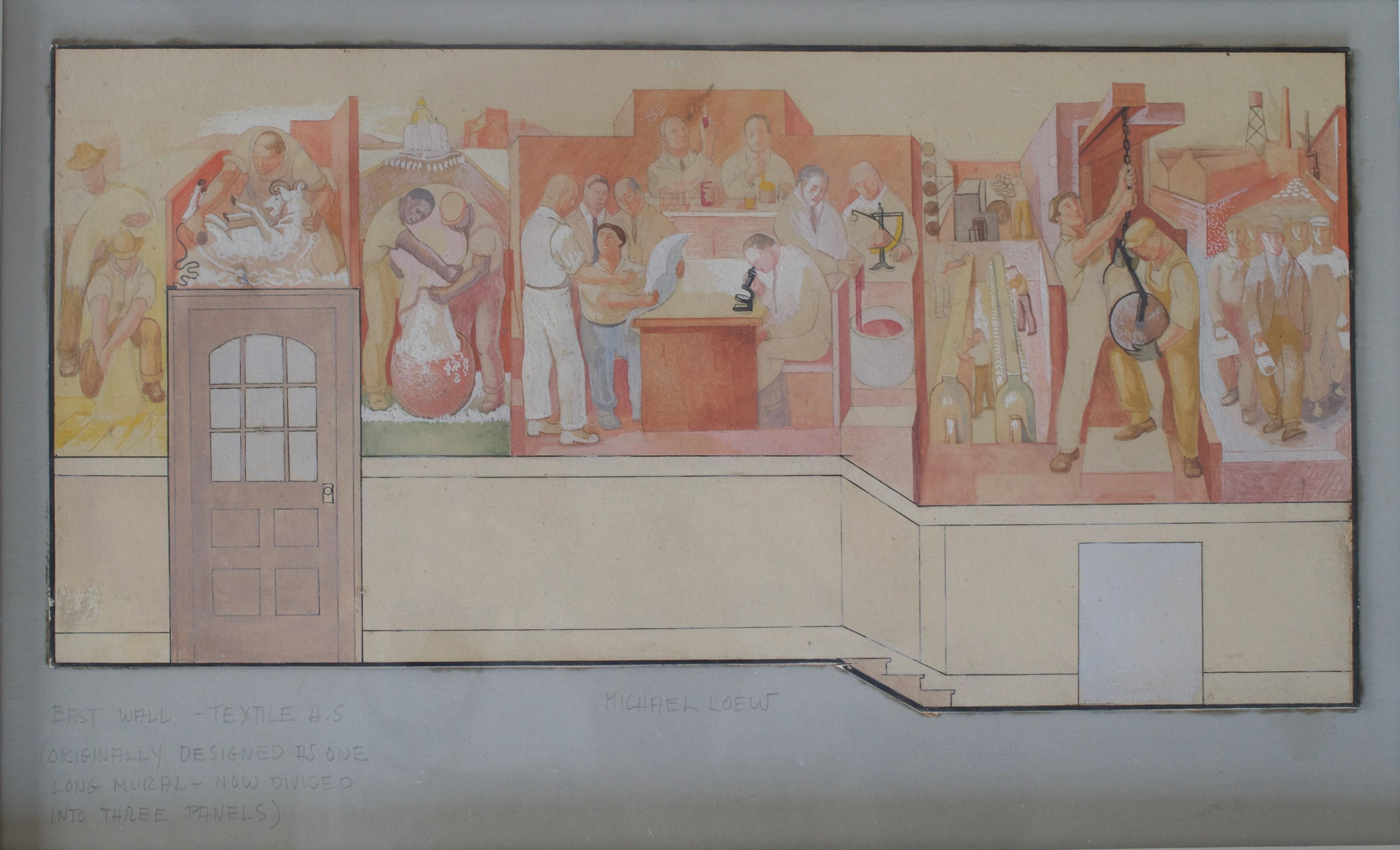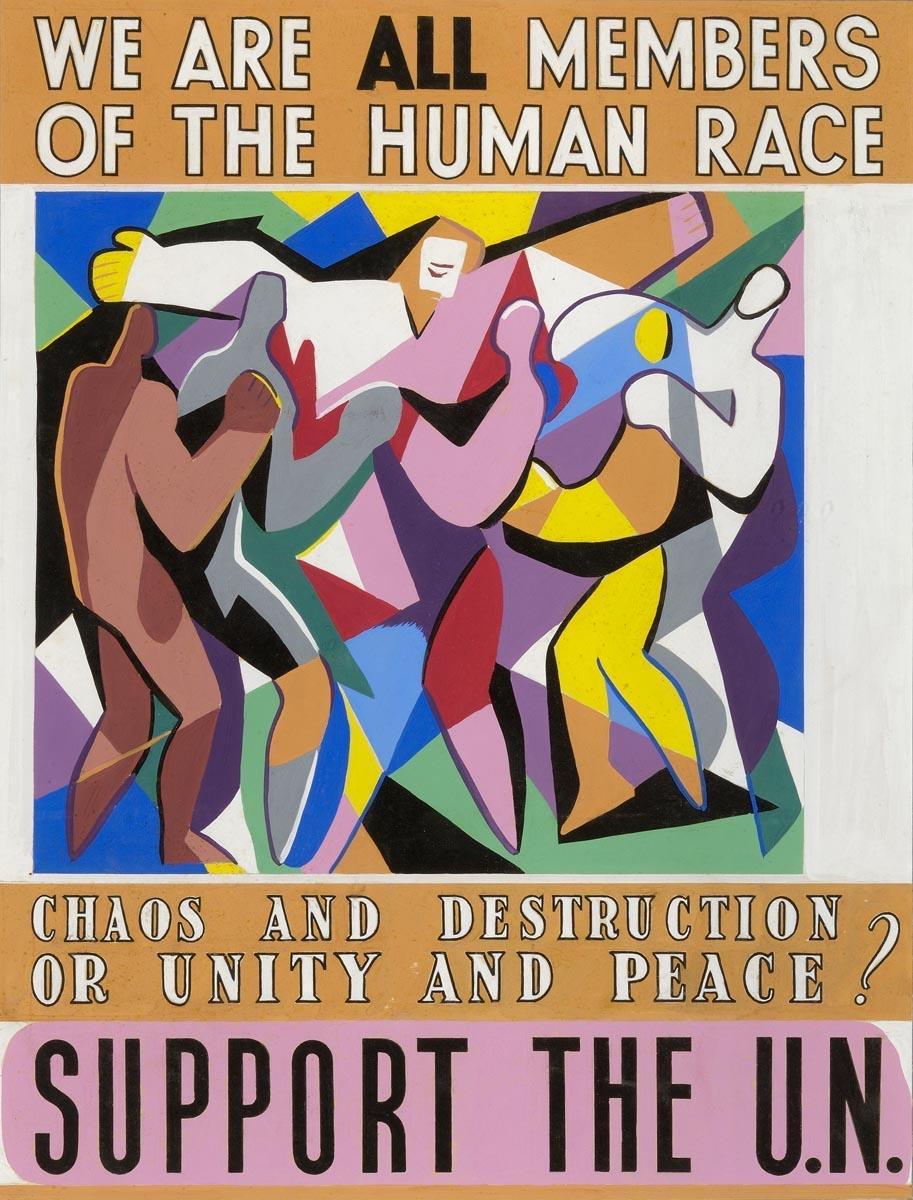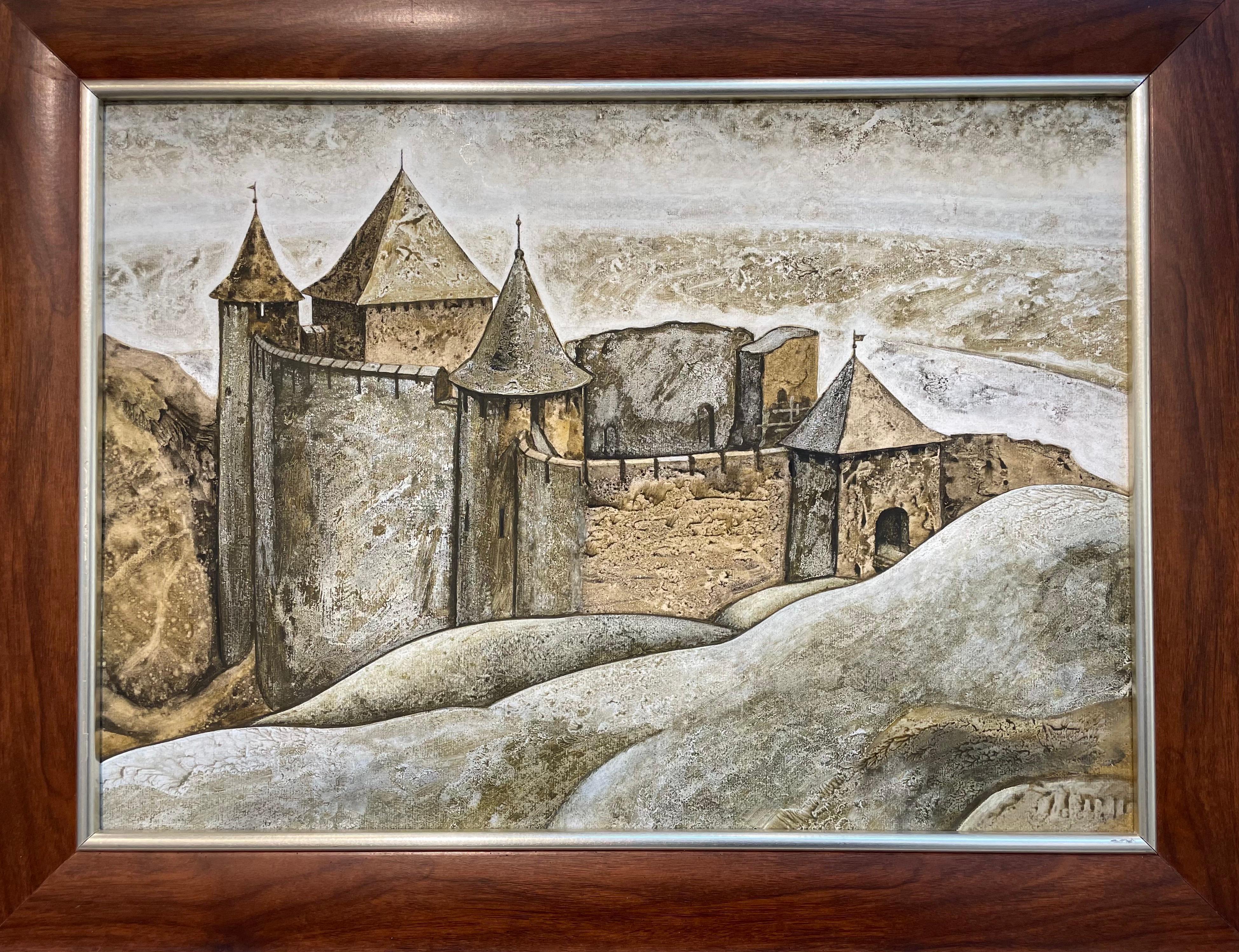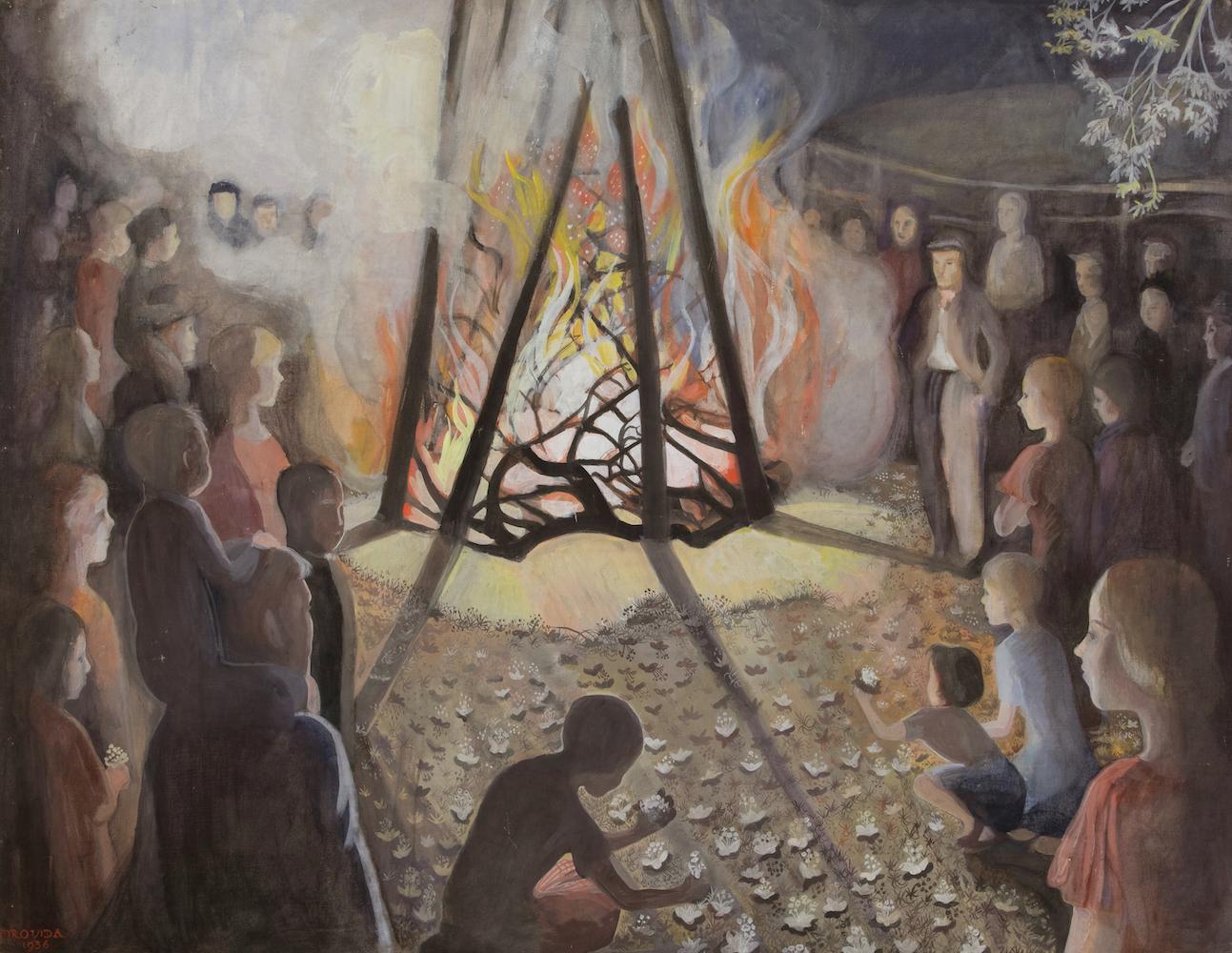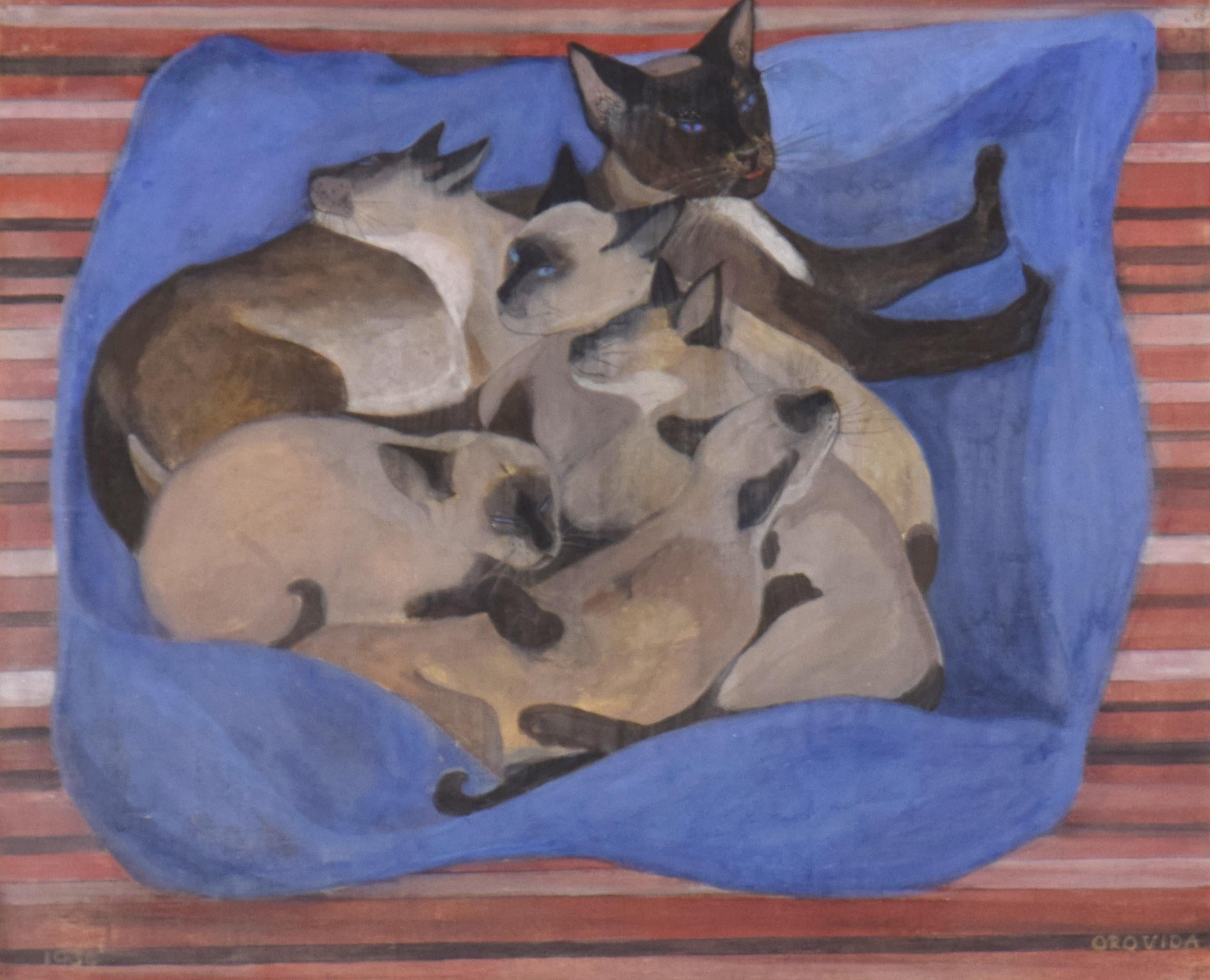Items Similar to The Rest, Egg Tempera, 20th Century English Painting
Want more images or videos?
Request additional images or videos from the seller
1 of 5
Francis PlummerThe Rest, Egg Tempera, 20th Century English Painting
About the Item
Egg Tempera on board, signed
Image size: 19 x 15 inches (48 x 38 cm)
Gilt frame
Plummer specialised in the medium of egg tempera, a technique little used since the frescos of the Renaissance, he often worked on a large scale, but in tremendous detail, combining Classical iconography and formal composition with visual exploration evocative of William Blake and Stanley Spencer. His principle focus is the depiction of the human form.
Plummer was instrumental in the rediscovery in the twentieth century of using egg tempera in art, finding that the method of painting successive layers and the resulting translucency were ideal in portraying the subtleties of skin tone and physical detail.
Francis Plummer exhibited widely during his lifetime at venues including the Leicester Galleries, Leighton House Galleries and the Alwyn Gallery in Mayfair in 1975.
- Creator:Francis Plummer (1930 - 2019)
- Dimensions:Height: 19 in (48.26 cm)Width: 15 in (38.1 cm)
- More Editions & Sizes:1 of 1Price: $3,841
- Medium:
- Movement & Style:
- Period:
- Condition:
- Gallery Location:London, GB
- Reference Number:1stDibs: LU52412626872
About the Seller
5.0
Vetted Seller
These experienced sellers undergo a comprehensive evaluation by our team of in-house experts.
Established in 2007
1stDibs seller since 2014
63 sales on 1stDibs
Typical response time: 3 hours
- ShippingRetrieving quote...Ships From: London, United Kingdom
- Return PolicyA return for this item may be initiated within 14 days of delivery.
More From This SellerView All
- The Shepherd, English Victorian 19th Century Egg TemperaLocated in London, GBSir William Blake Richmond KCB, RA, PPRBSA 1842 - 1921 The Shepherd Egg tempera on wooden panel, signed with initials bottom left Image size: 8 ¼ x 5 ½ inches Period gilt oak frame A newly discovered work by the artist. Sir William Blake Richmond KCB, RA, PPRBSA was an English portrait painter, sculptor and a designer of stained glass and mosaic. He is best known for his portrait work and decorative mosaics in St Paul's Cathedral in London. He was the son of the portraitist George Richmond RA and studied at the Royal Academy Schools in the early 1860s. Influenced by his father and by Sir John Everett Millais, he is best known for his mosaic decorations below the dome and in the apse of St Paul's Cathedral in London. His father, George Richmond, was one of 'the Ancients' who were a group of artists who formed around the visionary artist and poet William Blake. Samuel Palmer was an other of the ancients and a close friend of the family. Our painting could have been inspired by George Richmond’s engraving 'The Shepherd', 1827, but in our panel the shepherd is turned round facing away, and is playing a flute instead of resting on a staff. But the sheep and other elements are there. It is also suggestive of Welby Sherman's engraving after Samuel Palmer of the same name and date, but here the shepherd is sitting but like ours turned away. William Blake's is an altogether happier image given the figure is playing to his sheep. Our painting is playing with some of the same ideas and feels like the same sort of period, and the ‘fresco’ like chalk ground is interesting, as is the pen and ink finishing on the tempera. All three are strongly influenced by Blake's illustrations to Thornton's 'Virgil'. The shepherd and his flock are clearly based on Thenot and his sheep in the Frontispiece to Thornton. Blake Richmond wrote:"If there be the least value in my pictures, it is due to such lovely early impressions derived from the sweet poetic work of many of my father's contemporaries, Calvert, Blake and others, whose shadows are substance still to me" [Sir William Blake Richmond, letter to his father, 50 years after the death of William Blake, from Stirling op. cit p. 28]. Richmond was given private art lessons by John Ruskin before attending the Royal Academy for three years. After that he spent a number of years in Italy, where an encounter with a shepherd called Beppino, 'a splendid speciman of a Sabine Shepherd', could also have gave him the inspiration for the painting we show here. Richmond recalls how he met Beppino on the hillside, and was invited to share the shade of the shepherd's capanna, a wooden hut. 'What a place! In an instant of time I was back into the age of kings, and I knew Romulus had lived and am sure that he lived in a hut exactly like this one'. That night Richmond dined at Beppino's hut 'on roast kid, hard bread dipped in Roman wine, goat's cream and white ricotta'. The shepherd had such an impression on Richmond that he sought him out on a return visit to Italy some years later, but was saddened to hear that Beppino 'had joined his fore-fathers in the shades'. He was moved to write the following, which perfectly expresses the mood of this painting and his tribute to a fleeting companion: 'Little events of this kind unite past times with present, create and emphasis continuity of human instincts, which seem to defy time and make travel so intensely interesting and invigorating to a citizen of this world. One need not go to the palace, far otherwise, or to cities and towns to discover the kernal of enduring civilisations. One finds it, if one wills to do so, in the backbone of the world, an ancient peasantry who have watched and still watch the progress of the stars'. Richmond was influential in the early stages of the Arts and Crafts Movement in his selection of bold colours and materials for the mosaics in St. Paul's Cathedral and in his collaboration with James Powell and Sons...Category
1860s Victorian Figurative Paintings
MaterialsEgg Tempera, Ink
- The Triple Deity, 20th Century Egg TemperaBy Francis PlummerLocated in London, GBFrancis Plummer 1930 - 2019 The Triple Deity Egg Tempera on board, signed lower left Image size: 24 x 20 inches Gilt Framed Plummer specialised in th...Category
1950s Art Deco Figurative Paintings
MaterialsEgg Tempera
- The Prelude, Early 20th Century Egg Tempera on boardBy Francis PlummerLocated in London, GBFrancis Plummer 1930 - 2019 The Prelude Egg Tempera on board Image size: 39 ½ x 49 ¼ inches Original Frame This work comes from a rare collection of w...Category
Early 20th Century Figurative Paintings
MaterialsEgg Tempera
- The String Puppet, 20th Century Oil PaintingBy Alice Headley NeaveLocated in London, GBOil on canvas, signed bottom left Image size: 30 x 25 inches (76.25 x 63.5 cm) Alice Headley Neave was the daughter of Dr Arthur Henry Headley Huc...Category
20th Century Modern Figurative Paintings
MaterialsCanvas, Oil
- Come to Blows, 20th Century British Female Artist, GouacheBy Joan Fairfax Whiteside ARRC FMAALocated in London, GBGouache on card, signed lower right Image size: 19 3/4 x 11 1/4 inches (50 x 28.5 cm) Contemporary style hand made frame Joan Fairfax Whiteside Joan Fairfax Whiteside was a prodig...Category
20th Century Modern Figurative Paintings
MaterialsGouache
- St Valentine's Day, 20th Century Female Artist, Signed and Framed PaintingBy Joan Fairfax Whiteside ARRC FMAALocated in London, GBGouache on card, signed lower left Image size: 14 1/4 x 12 1/4 inches (36 x 31 cm) Contemporary style frame Joan Fairfax Whiteside Joan Fairfax Whiteside was a prodigious artist an...Category
Mid-20th Century Modern Figurative Paintings
MaterialsGouache, Cardboard
You May Also Like
- Mural Study 1933 Depression Era Mid-Century WPA Modern American Scene DrawingBy Michael LoewLocated in New York, NYMural Study 1933 Depression Era Mid-Century WPA Modern American Scene Drawing. Study to Scale Mural Sketch for “Evolution of Textile Production” East. All,...Category
1930s American Modern Figurative Paintings
MaterialsBoard, Egg Tempera
- UN Poster Design American Scene Mid 20th Century Modernism WPA World PeaceBy Jo CainLocated in New York, NYUN Poster Design American Scene Mid 20th Century Modernism WPA World Peace Jo Cain (1904 – 2003) We Are All Members of the Human Race: UN Poster Proposal 21 x...Category
1940s American Modern Figurative Paintings
MaterialsEgg Tempera, Board
- ParadeBy Catherine KoenigLocated in Buffalo, NYAn original egg tempera painting by American female artist Catherine Koenig.Category
1950s Modern Figurative Paintings
MaterialsEgg Tempera, Board
- Fort of KhotynLocated in Aberdeen Dyce, GBBorn on May 9, 1942, in the city of Chernivtsi. Graduated from the Moscow Higher Art and Industrial School (1972). Teachers in the specialty: A. Sklyarenko, I. Bogdashevsky, G. Vinog...Category
1970s Modern Figurative Paintings
MaterialsEgg Tempera
- Bonfire, Jubilee Night by Orovida Pissarro - Egg tempura painting, 1936By Orovida PissarroLocated in London, GBBonfire, Jubilee Night by Orovida Pissarro (1893 - 1968) Egg tempura on linen 86 x 111 cm (33 ⁷/₈ x 43 ³/₄ inches) Signed and dated lower left Executed in 1936 Provenance Private co...Category
1930s Modern Figurative Paintings
MaterialsLinen, Egg Tempera
- Siamese Cat with Kittens by Orovida Pissarro - Egg tempura paintingBy Orovida PissarroLocated in London, GBSiamese Cat with Kittens by Orovida Pissarro (1893-1968) Egg tempera on linen 39 x 48 cm (15³/₈ x 18⁷/₈ inches) Signed lower right Orovida and dated lower left 1934 Provenance J Ankri, 8th October 1967 Literature K L Erickson, Orovida Pissarro: Painter and Print-Maker with A Catalogue Raisonné of Paintings, (doctoral thesis), Oxford, 1992, Appendices, no. 51, p. 56 (illustrated) Exhibition London, The Leicester Galleries, Paintings by Orovida, February 1935, no. 6 Women’s International Art Club, 20th February - 13th March 1937, no. 273 London, Redfern Gallery, Ten Years of Work by Orovida, 5th-28th May 1938, no. 7 London, The Royal Society of British Artists, Summer Exhibition, 1947, no. 281 (possibly the etching) London, O’Hana Gallery, Paintings, Drawings and Coloured Etchings: Orovida, 3rd-18th October 1957, no. 13 Artist biography Orovida Camille Pissarro, Lucien and Esther Pissarro’s only child, was the first woman in the Pissarro family as well as the first of her generation to become an artist. Born in Epping, England in 1893, she lived and worked predominantly in London where she became a prominent member of several British arts clubs and societies. She first learned to paint in the Impressionist style of her father, but after a brief period of formal study with Walter Sickert in 1913 she renounced formal art schooling. Throughout her career, Orovida always remained outside of any mainstream British art movements. Much to Lucien's disappointment she soon turned away from naturalistic painting and developed her own unusual style combining elements of Japanese, Chinese, Persian and Indian art. Her rejection of Impressionism, which for the Pissarro family had become a way of life, together with the simultaneous decision to drop her famous last name and simply use Orovida as a ‘nom de peintre’, reflected a deep desire for independence and distance from the weight of the family legacy. Orovida's most distinctive and notable works were produced from the period of 1919 to 1939 using her own homemade egg tempera applied in thin, delicate washes to silk, linen or paper and sometimes embellished with brocade borders. These elegant and richly decorative works generally depict Eastern, Asian and African subjects, such as Mongolian horse...Category
1930s Modern Animal Paintings
MaterialsLinen, Egg Tempera
